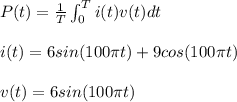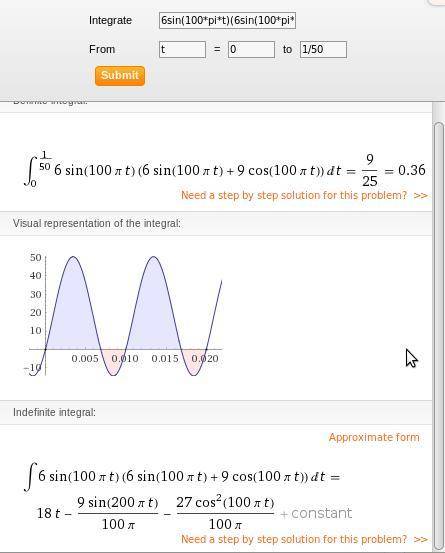
If the current and voltage of an electrical device (in the passive reference configuration) are v \left (t \ right) v (t) = 6 \sin\left(100\pi t\right)sin(100πt) V and i\left(t\right)i(t) = 6 \sin\left (100 \ pi t \ right) sin (100πt) + 9 \cos \left (100\pi t\right) cos (100πt) A. Then the average power delivered to the device (computed to one decimal place) is given by:.

Answers: 3
Another question on Physics

Physics, 21.06.2019 17:20
American eels (anguilla rostrata) are freshwater fish with long, slender bodies that we can treat as uniform cylinders 1.0 m long and 10 cm in diameter. an eel compensates for its small jaw and teeth by holding onto prey with its mouth and then rapidly spinning its body around its long axis to tear off a piece of flesh. eels have been recorded to spin at up to 14 revolutions per second when feeding in this way. although this feeding method is costly in terms of energy, it allows the eel to feed on larger prey than it otherwise could. 1.a field researcher uses the slow-motion feature on her phones camera to shoot a video of an eel spinning at its maximum rate. the camera records at 120 frames per second. through what angle does the eel rotate from one frame to the next? 2. the eel is observed to spin at 14 spins per second clockwise, and 10 seconds later it is observed to spin at 8 spins per second counterclockwise. what is the magnitude of the eels average angular acceleration during this time? 3. the eel has a certain amount of rotational kinetic energy when spinning at 14 spins per second. if it swam in a straight line instead, about how fast would the eel have to swim to have the same amount of kinetic energy as when it is spinning? 4.a new species of eel is found to have the same mass but one-quarter the length and twice the diameter of the american eel. how does its moment of inertia for spinning around its long axis compare to that of the american eel?
Answers: 1

Physics, 21.06.2019 23:30
Classify the following soils according to the uscs classification system. provide appropriate uscs designations. a) this sample of well-graded gravel with sand was obtained from a large earthen dam in vancouver, canada. the sample has 73% fine to coarse sub-angular gravel, 25% fine to coarse sub-angular sand and 2% fines. the maximum size of the particles is 75 mm. the coefficient of curvature is 2.7, while the uniformity coefficient is 12.4. b) this dark brown and wet soil with a “strong organic odor” has 100% passing the no. 200 sieve. the liquid limit of the material is 32% when not dried and is 21% when oven-dried. the plastic index is 21% when not dried. c) this sand has 61% predominantly fine sand, 23% silty fines, and 16% fine sub-rounded gravel size. the maximum size is 20 mm. the liquid limit is 33% and the plastic limit is 27%. d) this soil has 74% fine to coarse sub-angular reddish sand and 26% organic and silty dark brown fines. the liquid limit is 37% when not dried and is 26% when oven dried. the plastic index is 6% when not dried.
Answers: 1

Physics, 22.06.2019 05:40
Two polarizers are oriented at 40∘ to each other and plane-polarized light is incident on them. if only 16 percent of the light gets through both of them, what was the initial polarization direction of the incident light?
Answers: 2

Physics, 22.06.2019 10:30
In automobile steering wheel is shown what is the ideal mechanical advantage blank? if the ama is eight what is the efficiency of the steering wheel?
Answers: 1
You know the right answer?
If the current and voltage of an electrical device (in the passive reference configuration) are v \l...
Questions

Chemistry, 22.10.2019 20:00


Mathematics, 22.10.2019 20:00


Geography, 22.10.2019 20:00


Advanced Placement (AP), 22.10.2019 20:00


Mathematics, 22.10.2019 20:00


History, 22.10.2019 20:00






Mathematics, 22.10.2019 20:00











